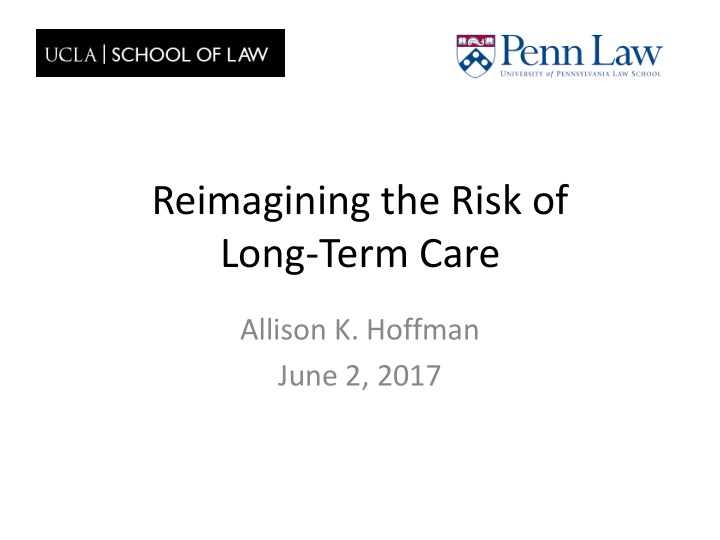



Reimagining the Risk of Long-Term Care Allison K. Hoffman June 2, 2017
What Risks Might Insurance for Long-Term Care Address? And How? Long-Term Care Insurance Risk: Care Recipient Risk Next Friend Risk Arrange/Pay for Response: Obtain care supports Provide Care Care 2
The Structure of Medicaid LTC Policy Shapes Our Conception of LTC Risk, one that Ensures Reliance on Friends & Family • Medicaid, by design, leaves gaps – Means-tested so most Americans have no LTC insurance unless they “spend down” – Caregiving did not fit original American concept of social insurance (to ameliorate threats to family wage) – Medicalization of LTC sidelines personal care • A shift from nursing home care to home-based care has increased this reliance 3
Home & Community-Based Services Comprise Increasing Share of LTC Spending: 1995-2013 Source: Steve Eiken et al., CMS and Truven Health Analytics 2015 4
Reimagining Private Obligation as Next-Friend Risk • Over 40M people provide some unpaid informal care; amount and intensity varies widely • Structure becoming untenable in a changing world • As a result, costs are high, including financial, emotional, and physical consequences – E.g., caregiver for parent who leaves work faces on average $300K in losses (lost income, benefits, etc.) – 20-30% with serious health harms (e.g., depression) Fits model of universal, unanticipated, largely uncontrollable harm 5
Implications of Understanding Next-Friend Risk • Redefines the scale of the problem – $470B “invisible copayment” • Insurance? Next Friend Risk • Flexibility • Tradeoffs Arrange/Pay for Provide Care Care Mitigate costs of Mitigate costs providing care of outsourcing ($$, health, care emotional) 6
Boundaries of Next-Friend Risk Must define: • What relationships count • Where does insurable harm begin (i.e., When does responsibility create insecurity?) • The harm – Variable opportunity costs and time and $$ spent – Contingent on income? 7
The Case for Insurance Policies that Better Mitigate Next Friend Risk • To protect against serious lifecycle risk and thus protect conditions of autonomy • To reduce disparate harm during key work, child- rearing years – 66% of informal caregivers are women – Low-income households • To build critical infrastructure development for a future generation of care recipients • To reshape choices and social narrative of responsibility; paternalistic benefits 8
Objections and Concerns • To state intervention – Privacy – Commodification • Moral hazard Medicaid Out-of- 19% Pocket • Fraud or neglect 7% Other • Cost Private Informal 4% Care 69% – Would triple current Other Public funding levels 1% Total = ~690B 9
Reimagining the Risk of Long-Term Care Allison K. Hoffman June 2, 2017
BACKUP 11
The Care Recipient Perspective ~10M Americans; Just Over Half Over Age 65 Age 65+ 4.6M Community Nursing Age 65+ Residents Home 1.3M 8.8M (86%) Residents 1.5M (14%) Under 65 Under 65 4.2M 0.17M Source: Kaiser Commission on Medicaid and the Uninsured:; Health Policy Institute 12 Georgetown, Analysis of data from 2005 NHIS and 2004 National Nursing Home Survey
A Snapshot of Funding for Formal Long- Term Care; Medicaid Top Source 5% Medicaid 12% Out-of-Pocket Other Private 61% Other Public 22% 2012 Total = ~220B Source: National Health Policy Forum, National Spending for Long-Term Services and Supports, 2012 (March 27, 2014). Note: Excludes Medicare post-acute care. “Other Private” includes private insurance and other private spending for nursing homes and home health services. “Other Public” includes VA, state and local programs and general assistance spending for nursing homes and home health services, and other federal programs for home health services. “Out-of-Pocket” spending includes deductibles, copayments, & amounts not covered by health insurance. 13
Recommend
More recommend